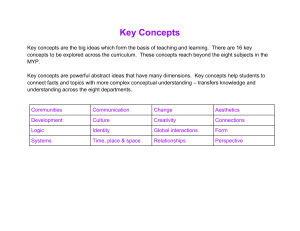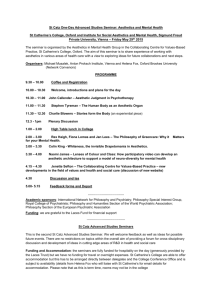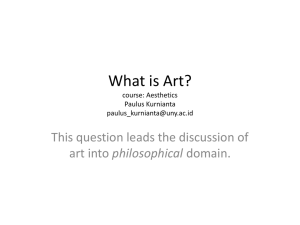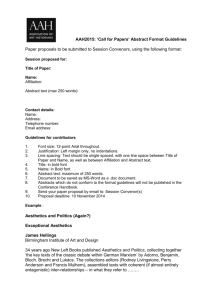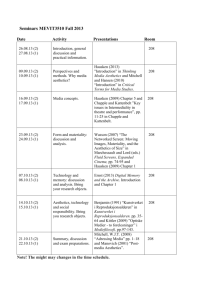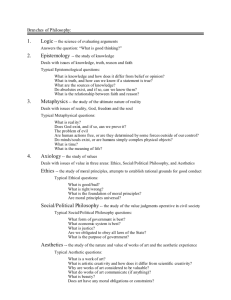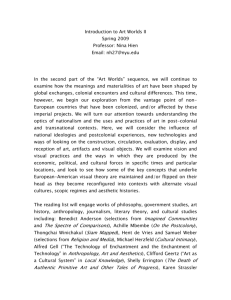PLEASE NOTE this is a sample reading list for the... may change from year to year.
advertisement
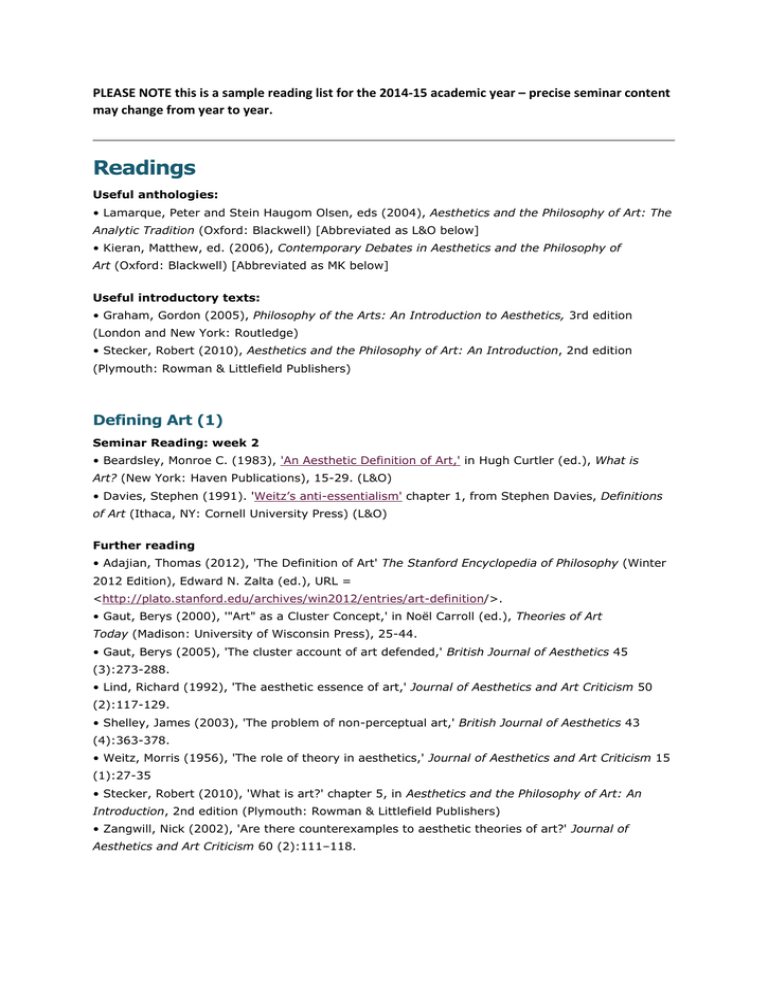
PLEASE NOTE this is a sample reading list for the 2014-15 academic year – precise seminar content may change from year to year. Readings Useful anthologies: • Lamarque, Peter and Stein Haugom Olsen, eds (2004), Aesthetics and the Philosophy of Art: The Analytic Tradition (Oxford: Blackwell) [Abbreviated as L&O below] • Kieran, Matthew, ed. (2006), Contemporary Debates in Aesthetics and the Philosophy of Art (Oxford: Blackwell) [Abbreviated as MK below] Useful introductory texts: • Graham, Gordon (2005), Philosophy of the Arts: An Introduction to Aesthetics, 3rd edition (London and New York: Routledge) • Stecker, Robert (2010), Aesthetics and the Philosophy of Art: An Introduction, 2nd edition (Plymouth: Rowman & Littlefield Publishers) Defining Art (1) Seminar Reading: week 2 • Beardsley, Monroe C. (1983), 'An Aesthetic Definition of Art,' in Hugh Curtler (ed.), What is Art? (New York: Haven Publications), 15-29. (L&O) • Davies, Stephen (1991). 'Weitz’s anti-essentialism' chapter 1, from Stephen Davies, Definitions of Art (Ithaca, NY: Cornell University Press) (L&O) Further reading • Adajian, Thomas (2012), 'The Definition of Art' The Stanford Encyclopedia of Philosophy (Winter 2012 Edition), Edward N. Zalta (ed.), URL = <http://plato.stanford.edu/archives/win2012/entries/art-definition/>. • Gaut, Berys (2000), '"Art" as a Cluster Concept,' in Noël Carroll (ed.), Theories of Art Today (Madison: University of Wisconsin Press), 25-44. • Gaut, Berys (2005), 'The cluster account of art defended,' British Journal of Aesthetics 45 (3):273-288. • Lind, Richard (1992), 'The aesthetic essence of art,' Journal of Aesthetics and Art Criticism 50 (2):117-129. • Shelley, James (2003), 'The problem of non-perceptual art,' British Journal of Aesthetics 43 (4):363-378. • Weitz, Morris (1956), 'The role of theory in aesthetics,' Journal of Aesthetics and Art Criticism 15 (1):27-35 • Stecker, Robert (2010), 'What is art?' chapter 5, in Aesthetics and the Philosophy of Art: An Introduction, 2nd edition (Plymouth: Rowman & Littlefield Publishers) • Zangwill, Nick (2002), 'Are there counterexamples to aesthetic theories of art?' Journal of Aesthetics and Art Criticism 60 (2):111–118. Defining Art (2) Seminar reading: week 3 • Abell, Catharine (2012), 'Art: What it Is and Why it Matters,' Philosophy and Phenomenological Research 85 (3):671-691. • Lopes, Dominic McIver (2008), 'Nobody needs a theory of art,' Journal of Philosophy 105 (3):109-127. Further reading • Danto, Arthur (1964), 'The artworld,' Journal of Philosophy 61 (19):571-584. (L&O) • Dickie, George (1983) 'The New Institutional Theory of Art', Proceedings of the 8th international Wittgenstein Symposium 10: 57-64 (L&O) • Dickie, George (2004), 'Defining art: Intension and extension,' in Peter Kivy (ed.), The Blackwell Guide to Aesthetics (Oxford: Blackwell Pub). • Levinson, Jerrold (1979), 'Defining art historically' British Journal of Aesthetics 19 (3):21-33. (L&O) • Levinson, Jerrold (1989), 'Refining art historically' Journal of Aesthetics and Art Criticism 47 (1):21-33. • Lopes, Dominic McIver (2014), Beyond Art (Oxford: OUP) • Schellekens, Elisabeth (2014) 'Conceptual Art', The Stanford Encyclopedia of Philosophy (Winter 2014 Edition), Edward N. Zalta (ed.), URL = <http://plato.stanford.edu/archives/win2014/entries/conceptual-art/>. • Stecker, Robert (1986), 'The End of an Institutional Definition of Art,' British Journal of Aesthetics 26 (2):124-132. Intentions and Interpretation Seminar reading: week 4 • Davies, Stephen (2006) ‘Author’s Intentions, Literary Interpretation, and Literary Value’, British Journal of Aesthetics 46: 223-247 • Goldman, Alan H. (1990), 'Interpreting art and literature,' Journal of Aesthetics and Art Criticism 48 (3):205-214. Also, have a look at Plan 9 from Outer Space: http://youtu.be/u2ukRYsYPmo (trailer), you might want to compare this to Garth Merenghi's Darkplace:http://youtu.be/R-1-62TcN70?list=RDR-162TcN70 Further reading • Davies, Stephen (2010), 'The hypothetical intentionalist's dilemma: A reply to Levinson,' British Journal of Aesthetics 50 (3):307-312. • Iseminger, Gary (1996), 'Actual intentionalism vs. hypothetical intentionalism,' Journal of Aesthetics and Art Criticism 54 (4):319-326. • Nathan, Daniel (1992), 'Irony, metaphor, and the problem of intention,' in Gary Iseminger (ed.), Intention and Interpretation (Temple University Press), 183--202. • Levinson, Jerrold (1996) ‘Intention and Interpretation in Literature,’ in The Pleasures of Aesthetics (Ithaca, NY: Cornell University Press), 175-213 (L&O) • Livingston, Paisley (2010), 'Authorial intention and the varieties of intentionalism,' in Garry Hagberg & Walter Jost (eds.), A Companion to the Philosophy of Literature (Oxford: WileyBlackwell). • Stecker, Robert (2006), 'Moderate actual intentionalism defended,' Journal of Aesthetics and Art Criticism 64 (4):429-438. • Stecker, Robert (2010), 'Interpretation and the Problem of the Relevant Intention', chapter 7 • Wimsatt, W. K. and Beardsley, Monroe C. (1954), ‘The Intentional Fallacy’, in The Verbal Icon: Studies in the Meaning of Poetry (Lexington: University of Kentucky Press), 3-18. • Nehamas, Alexander (1981), 'The Postulated Author: Critical Monism as a Regulative Ideal,' Critical Inquiry 8 (1):133. Art, Truth and Knowledge Seminar reading: week 5 • Berys Gaut, Art and Cognition (MK) • Peter Lamarque, Cognitive Values in the Arts: Marking the Boundaries (MK) - Note: references for both papers are at the end of the Lamarque paper. Further reading • Conolly, Oliver and Bashshar Haydar (2007), ‘Literature, Knowledge, and Value’, Philosophy and Literature 31: 111-124 • Harrison, Bernard (2009), 'Realism,' in Richard Eldridge (ed.), The Oxford Handbook of Philosophy and Literature. OUP. • Gibson, John (2009), 'Literature and Knowledge,' in Richard Eldridge (ed.), The Oxford Handbook of Philosophy and Literature. OUP. • John, Eileen (1998), ‘Reading Fiction and Conceptual Knowledge: Philosophical Thought in Literary Context’, Journal of Aesthetics and Art Criticism 56: 221-348 • Lamarque, Peter (2009), 'Poetry and abstract thought,' Midwest Studies in Philosophy 33 (1):3752. • Lamarque, Peter and Stein H. Olsen (1994), Truth, Fiction, and Literature: A Philosophical Perspective. OUP. • Robinson, Jenefer (1995), ‘L’Éducation Sentimentale’, Australasian Journal of Philosophy 73: 212-226 • Stolnitz, Jerome (1992), ‘On the Cognitive Triviality of Art’, British Journal of Aesthetics 32: 191200 • Wilson, Catherine (1983), 'Literature and Knowledge,' Philosophy 58 (226): 489 - 496. Art and moral value Seminar reading: week 7 • Eileen John, 'Artistic Value and Opportunistic Moralism’ (MK) • Daniel Jacobson, ‘Ethical Criticism and the Vice of Moderation’ (MK) You might want to read the Guardian article on The Death of Klinghoffer: http://www.theguardian.com/music/2014/oct/21/the-death-of-klinghoffer-panel-artcensor and here's the youtube clip of the trailor for the Met production: http://youtu.be/FtnXSra0ZYQ Further reading • Anderson, James and Jeffrey Dean (1998), ‘Moderate Autonomism’, British Journal of Aesthetics 38: 150-166 • Carroll, Noël (1996) ‘Moderate Moralism’, British Journal of Aesthetics 36 (1996): 223-238 • Devereaux, Mary (1998) ‘Beauty and Evil: The Case of Leni Riefenstahl’s Triumph of the Will’, in Jerrold Levinson (ed.), Aesthetics and Ethics: Essays at the Intersection (Cambridge: Cambridge University Press), 227-256 • Eaton, Anne W. (2012), ‘Robust Immoralism’, Journal of Aesthetics and Art Criticism 70: 281-92 • Gaut, Berys (1998), 'The Ethical Criticism of Art,' in Jerrold Levinson (ed.), Aesthetics and Ethics: Essays at the Intersection (Cambridge: Cambridge University Press), 182--203. • Kieran, Matthew (1996), 'Art, imagination, and the cultivation of morals,' Journal of Aesthetics and Art Criticism 54 (4):337-351. Fiction and Emotion Seminar reading: Week 8 • Gendler and Kovakovich, ‘Genuine Rational Fictional Emotions’ (MK) • Matravers, ‘The Challenge of Irrationalism and How Not to Meet it’ (MK) Further reading • Glenn A. Hartz (1999), 'How we can be moved by Anna Karenina, Green Slime, and a Red Pony,' Philosophy 74 (4):557-578. • Walton, Kendall L. (1978), 'Fearing fictions,' Journal of Philosophy 75 (1):5-27. • Neill, Alex (1991), 'Fear, fiction and make-believe' Journal of Aesthetics and Art Criticism 49 (1):47-56. • Peter Lamarque (1981), 'How can we fear and pity fictions?' British Journal of Aesthetics 21 (4):291-304. • Radford, Colin and Michael Weston (1975), 'How Can We Be Moved by the Fate of Anna Karenina?' Aristotelian Society Supplementary Volume 49:67 - 93. Forgeries, Copies and Appropriation Art Seminar reading: week 9 • Hick, Darren Hudson (2010), 'Forgery and Appropriation in Art,' Philosophy Compass 5 (12):1047-1056. • Irvin, Sherri (2005), 'Appropriation and authorship in contemporary art,' British Journal of Aesthetics 45 (2):123-137. Also, please read the article and watch the youtube clip: http://www.channel4.com/news/artforgery-beltracchi-wolfgang-ernst-picasso-paraic-obrien http://www.afterwalkerevans.com/ Further reading • Dutton, Denis (1979), 'Artistic crimes: The problem of forgery in the arts,' British Journal of Aesthetics 19 (4):302-314. • Graham, Gordon (2006), 'Aesthetic empiricism and the challenge of fakes and ready-mades', in Matthew Kieran (ed.), Contemporary Debates in Aesthetics and the Philosophy of Art (Oxford: Blackwell), 11--21. • Hick, D. H. (2012), 'Art Forgery: The History of a Modern Obsession,' British Journal of Aesthetics 52 (4):427-430. • Lessing, Alfred (1965), 'What is wrong with a forgery?' Journal of Aesthetics and Art Criticism 23 (4):461-471. • Mag Uidhir, Christy (2011), 'Minimal Authorship (of Sorts),' Philosophical Studies 154 (3):373387. Erotic Art Seminar reading: Week 10 • Maes, Hans (2011), 'Art or Porn: Clear division or false dilemma?' Philosophy and Literature 35 (1):51-64. • Zamir, Tzachi (2013), 'Pornography and Acting,' in Hans Maes (ed.), Pornographic Art and the Aesthetics of Pornography (Palgrave Macmillan). Further reading • Kieran, Matthew (2001), 'Pornographic art,' Philosophy and Literature 25 (1):31-45. • Maes, Hans (2011), 'Drawing the Line: Art versus Pornography,' Philosophy Compass 6 (6):385397. • Maes, Hans & Levinson, Jerrold (eds.) (2012), Art & Pornography: Philosophical Essays (Oxford: Oxford University Press). • Zamir, Tzachi (2013), 'Unethical Acts,' Philosophical Quarterly 63 (251):353-373. The Science of Aesthetics • Currie, Gregory (2005), 'Aesthetics and Cognitive Science,' in Jerrold Levinson The Oxford Handbook of Aesthetics (Oxford: Oxford University Press). • Davies, David (2014), ‘“This is Your Brain on Art”: What Can Philosophy of Art Learn from Neuroscience?’ in Currie, Kieran, Meskin and Robson (eds)Aesthetics and The Sciences of Mind (Oxford: Oxford University Press), 57-74. • Kamber, Richard (2011). 'Experimental Philosophy of Art,' Journal of Aesthetics and Art Criticism 69 (2):197-208. • Meskin, Aaron, Phelan, Mark, Moore, Margaret & Kieran, Matthew (2013), 'Mere Exposure to Bad Art,' British Journal of Aesthetics 53 (2):139-164.
